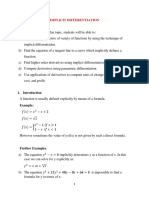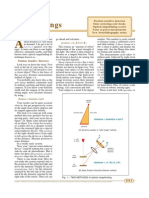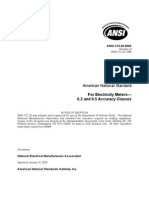Rate of Change
Rate of Change
Uploaded by
ksoskCopyright:
Available Formats
Rate of Change
Rate of Change
Uploaded by
ksoskOriginal Description:
Copyright
Available Formats
Share this document
Did you find this document useful?
Is this content inappropriate?
Copyright:
Available Formats
Rate of Change
Rate of Change
Uploaded by
ksoskCopyright:
Available Formats
47
Section 2.8 Related Rates
The problem of finding a rate of change from other known rates of change is called a related rates
problem.
3 2 4
3
4
dV dV dr dr
V r r
dt dr dt dt
t t = = =
Example
Water runs into a conical tank at the rate of 9
3
/ min ft . The tank stands point down and has a height of
10 ft and a base radius of 5 ft. How fast is the water level rising when the water is 6 ft deep?
Solution
V = volume
( )
3
ft of the water in the tank at time t (min)
x = radius ( ) ft of the surface of the water at time t
y = depth ( ) ft of the water in the tank at time t.
Given:
3
9 6
10 5
ft
m t in
dV
d
ft
ft
y
h r ft
= =
= =
The water forms a cone with volume:
2 1
3
V x y t =
From the triangles:
5
10 2
y
x
x
y
= =
2
1
3 2
y
V y t
| |
=
|
\ .
2
1
3 4
y
y t
| |
= |
|
\ .
3 1
12
y t =
The derivative in function of time:
2 1
3
12
dy
dV
y
dt dt
t
| |
=
|
\ .
( )
2
9 6
4
dy
dt
t
=
( ) ( ) 9 4
36
dy
dt t
=
1
0.3183
dy
dt t
= ~
The water level is rising at about 0.32 ft/min.
48
Related Rates Problem Strategy
1. Draw a picture and name the variables and constants. (use t for time).
2. Write down the given information (numerical).
3. Write down what you are asked to find.
4. Write an equation that relates the variables.
5. Differentiate with respect to t.
6. Evaluate.
Example
A hot air balloon rising straight up from a level filed is tracked by a range finder 500 ft from the liftoff
point. At the moment the range finders elevation angle is
4
t
, the angle is increasing at the rate of 0.14
rad/min. How fast is the balloon rising at that moment?
Solution
u = the angle in rad.
y = the height in feet of the balloon
Given: /
4
min 0.14 rad
d
dt
when
u t
u = =
500 distance ft =
tan 500tan
500
y
y u u = =
( )
2
500 sec
dy
d
dt dt
u
u =
( )
( )
2
4
500 sec 0.14
t
=
140 =
The balloon is rising at the rate of 140 ft/min.
49
Example
A police cruiser, approaching a right-angle intersection from the north, is chasing a speeding car that has
turned the corner and is now moving straight east. When the cruiser is 0.6 mi north of the intersection and
the car is 0.8 mi to the east, the police determined with radar that the distance between them and the car is
increasing at 20 mph. If the cruiser is moving at 60mph at the instant of measurement, what is the speed
of the car?
Solution
x = position of car at time t.
y = position of cruiser at time t.
s = distance between car and cruiser at time t.
Given:
0.8 0.6
20 60 mph mph
x y
dy
ds
dt
mi mi
dt
= =
= =
Using the Pythagorean Theorem to get the distance:
2 2 2
s x y = +
2 2 2 2
0.8 0.6 1 x y s = + = + =
( ) ( ) ( )
2 2 2 d d d
s x y
dt dt dt
= +
2 2 2
dy
ds dx
s x y
dt dt dt
= +
dy
ds dx
s y x
dt dt dt
=
dy
dx ds
x s y
dt dt dt
=
( ) ( ) ( ) ( ) 0.8 1 20 0.6 60
dx
dt
=
20 36
0.8
70
dx
dt
+
= =
The cars speed is 70 mph.
50
Example
A particle moves clockwise at a constant rate along a circle of radius 10 ft centered at the origin. The
particles initial position is (0, 10) on the y-axis and its final destination is the point (10, 0) on the x-axis.
Once the particle is in motion, the tangent line at P intersects the x-axis at a point Q (which moves over
time). If it takes the particle 30 sec to travel from start to finish, how fast is the point Q moving along the
x-axis when it is 20 ft from the center of the circle?
Solution
Since the particle travels 30 sec from start to finish of angle 90
2
t
= , the particle is traveling along
the circle at a constant rate of
sec 60 2
30 1 sec min
/ min
rad
rad
t
t =
That implies
d
dt
u
t =
/ min 20 rad
d
d
t
x and ft
u
t = =
10 10
cos 10sec
cos
x
x
u u
u
= = =
20 10sec sec 2 u u = =
( ) 10sec
dx d
dt dt
u =
10sec tan
d
dt
u
u u =
( ) 10sec tan u u t =
10 sec tan t u u =
20 10sec sec 2 u u = =
2
tan sec 1 4 1 3 u u = = =
10 sec tan
dx
dt
t u u =
( )
( )
10 2 3 t =
20 3 t =
The point Q is moving towards the origin at the speed of / min 20 3 108.8 ft t ~
x
y
P
Q
(x, 0)
10
u
0
51
Example
A jet airliner is flying at a constant altitude of 12,000 ft above sea level as it approaches a Pacific island.
The aircraft comes within the direct line of sight of a radar station located on the island, and the radar
indicates the initial angle between sea level and its line of sight to the aircraft is 30. How fast (in miles
per hour) is the aircraft approaching the island when first detected by the radar instrument if it is turning
upward (counterclockwise ccw) at the rate of
2
3
deg / sec in order to keep the aircraft within its direct
line of sight?
Solution
From the triangle:
12,000
tan
12, 000
tan x
x u
u = =
12,000
5280
cot mi u =
12,000
2
5280
csc
dx d
dt dt
u
u =
( ) ( )
12,000
2
5280 6
3600 2
csc
3 180
deg
sec
sec 1hr
t t
=
/ 380 mi hr ~
The negative appears because the distance x is decreasing, so the aircraft is approaching the island at a
speed of approximately 380 mi/hr when first detected by the radar.
52
Example
A rope is running through a pulley at P and bearing a weight W at one end. The other end is held 5 ft
above the ground in the hand M of a worker. Suppose the pulley is 25 ft above ground, the rope is 45 ft
long, and the worker is walking rapidly away from the vertical line PW at the rate of 6 ft/sec. How fast is
the weight being raised when the workers hand is 21 ft away from PW?
Solution
Given: 21 6
dx
when x
dt
= =
45 20 45 20 25 z h h h z = + = + = +
2 2 2
20 x z = +
( )
2 2 2
25 20 h x + = +
( )
( ) ( )
2 2 2
25 20
d d
h x
dt dt
+ = +
( ) 2 25 2
dh dx
h x
dt dt
+ =
25
dh x dx
dt h dt
=
+
( )
2 2 2 2 2
21 25 20 20 21 841 when x h x = + = + = + =
25 841 29 h + = =
( ) / sec
21
6
29
4.3 ft
dh
dt
= ~
As the rate 4.3 ft/sec at which the weight is being raised when x = 21 ft.
53
Exercises Section 2.8 Related Rates
1. If
2
y x = and 3
dx
dt
= , then what is 1
dy
when x
dt
=
2. If
3
x y y = and 5
dy
dt
= , then what is 2
dx
when y
dt
=
3. A cone-shaped icicle is dripping from the roof. The radius of the icicle is decreasing at a rate of 0.2
cm per hour, while the length is increasing at a rate of 0.8 cm per hour. If the icicle is currently 4 cm
in radius and 20 cm long, is the volume of the icicle increasing or decreasing and at what rate?
4. A cubes surface area increases at the rate of 72
2
/ sec in . At what rate is the cubes volume
changing when the edge length is x = 3 in?
5. The radius r and height h of a right circular cone are related to the cones volume V by the equation
2 1
3
V r h t = .
a) How is
dV
dt
related to
dh
dt
if r is constant?
b) How is
dV
dt
related to
dr
dt
if h is constant?
c) How is
dV
dt
related to
dr
dt
and
dh
dt
if neither r nor h is constant?
6. The voltage V (volts), current I (amperes), and resistance R (ohms) of an electric circuit like the one
shown here are related by the equation V IR = . Suppose that V is increasing at the rate of 1 volt/sec
while I is decreasing at the rate of / sec
1
3
amp . Let t denote time in seconds.
a) What is the value of
dV
dt
?
b) What is the value of
dI
dt
?
c) What equation relates
dR
dt
to
dV
dt
and
dI
dt
?
d) Find the rate at which R is changing when V = 12 volts and I = 2 amp. Is R increasing or
decreasing?
54
7. Let x and y be differentiable functions of t and let
2 2
s x y = + be the distance between the points
(x, 0) and (0, y) in the xyplane.
a) How is
ds
dt
related to
dx
dt
if y is constant?
b) How is
ds
dt
related to
dx
dt
and
dy
dt
if neither x nor y is constant?
c) How is
dx
dt
related to
dy
dt
if s is constant?
8. A 13-ft ladder is leaning against a house when its base starts to slide away. By the time the base is
12 ft from the house, the base is moving at the rate of 5 ft/sec.
a) How fast is the top of the ladder sliding down the wall then?
b) At what rate is the area of the triangle formed by the ladder, wall, and the ground changing
then?
c) At what rate is the angle u between the ladder and the ground changing then?
9. A 13-ft ladder is leaning against a vertical wall when he begins pulling the foot of the ladder away
from the wall at a rate of 0.5 ft/s. How fast is the top of the ladder sliding down the wall when the
foot of the ladder is 5 ft from the wall?
10. A 12-ft ladder is leaning against a vertical wall when he begins pulling the foot of the ladder away
from the wall at a rate of 0.2 ft/s. What is the configuration of the ladder at the instant that the
vertical speed of the top of the ladder equals the horizontal speed of the foot of the ladder?
55
11. A swimming pool is 50 m long and 20 m wide. Its length decreases linearly along the length from 3
m to 1 m. It is initially empty and is filed at a rate of 1
3
/ min m .
a) How fast is the water level rising 250 min after the filling begins?
b) How long will it take to fill the pool?
12. An inverted conical water tank with a height of 12 ft and a radius of 6 ft is drained through a hole in
the vertex at a rate of 2
3
/ sec ft . What is the rate of change of the water depth when the water
depth is 3 ft? (Hint: Use similar triangles.)
13. A hemispherical tank with a radius of 10 m is filled from an inflow pipe at a rate of
3
3 / min m .
(Hint: The volume of a cap of thickness h sliced from a sphere of radius r is
( )
2
3
3
h r h t
).
a) How fast is the water level rising when the water level is 5 m from the bottom of the tank?
b) What is the rate of change of the surface area of the water when the water is 5 m deep?
56
14. A fisherman hooks a trout and reels in his line at 4 in/sec. Assume the trip of the fishing rod is 12 ft
above the water directly above the fisherman and the fish is pulled horizontally directly towards the
fisherman. Find the horizontal peed of the fish when it is 20 ft from the fisherman.
15. Water is flowing at the rate of 6
3
/ min m from a reservoir shaped like a hemispherical bowl of
radius 13 m. Answer the following questions, given that the volume of water in a hemispherical
bowl of radius R is
2
3
3
V y R y
when the water is y meters deep.
a) At what rate the water level changing when the water is 8 m deep?
b) What is the radius r of the waters surface when the water is y m deep?
c) At what rate is the radius r changing when the water is 8 m deep?
16. A spherical balloon is inflated with helium at the rate of
3
100 / min ft . How fast is the balloons
radius increasing at the instant the radius is 5 ft? How fast the surface area increasing?
17. A balloon rising vertically above a level, straight road at
a constant rate of 1 ft/sec. Just when the balloon is 65 ft
above the ground, a bicycle moving at a constant rate of
17 ft/sec passes under it. How fast is the distance s t
between the bicycle and the balloon increasing 3 sec
later?
57
18. An observer stands 300 ft from the launch site of a hot-air balloon. The balloon is launched
vertically and maintains a constant upward velocity of 20 ft/sec. what is the rate of change of the
angle of elevation of the balloon when it is 400 ft from the ground? The angle of elevation is the
angle between the observers line of sight to the balloon and the ground.
19. A dinghy is pulled toward a dock by a rope from the bow through a ring on the dock 6 ft above the
bow. The rope is hauled in at rate of 2 ft/sec.
a) How fast is the boat approaching the dock when 10 ft of rope are out?
b) At what rate is the angle changing at this instant?
20. The figure shows a boat 1 km offshore, sweeping the shore with a searchlight. The light turns at a
constant rate, / sec 0.6 rad
d
dt
.
a) How fast is the light moving along the shore when it reaches point A?
b) How many revolutions per minute is 0.3 rad/sec?
21. You are videotaping a race from a stand 132 ft from the track,
following a car that is moving at 180 mi/h (264 ft/sec). How fast
will your camera angle be changing when the car is right in
front of you? A half second later?
58
22. The coordinates of a particle in the metric xyplane are differentiable functions of time t with
1 / sec
dx
m
dt
and 5 / sec
dy
m
dt
. How fast is the particles distance from the origin changing as
it passes through the point (5, 12)?
23. A particle moves along the parabola
2
y x in the first quadrant in such a way that its x-coordinate
(measure in meters) increases at a steady 10 m/sec. How fast is the angle of inclination of the line
joining the particle to the origin changing when x = 3m?
24. Coffee is draining from a conical filter into a cylindrical coffeepot at the rate of 10
3
/ min in .
a) How fast is the level in the pot rising when the coffee in the cone is 5 in. deep?
b) How fast is the level in the cone falling then?
25. A light shines from the top of a pole 50 ft high. A ball is dropped from the same height from a point
30 ft away from the light. How fast is the shadow of the ball moving along the ground
1
2
sec later?
(Assume the ball falls a distance
2
16 s t ft in t sec.)
59
26. To find the height of a lamppost, you stand a 6 ft pole 20 ft from the lamp and measure the length a
of its shadow, finding it to be 15 ft, give or take an inch. Calculate the height of the lamppost using
the value of a = 15 and estimate the possible error in the result.
27. On a morning of a day when the sun will pass directly overhead, the shadow of an 80ft building on
level ground is 60 ft long. At the moment in question, the angle the sun makes with the ground is
increasing at the rate of 0.27 / min. At what rate is the shadow decreasing?
28. A spherical iron ball 8 in. in diameter is coated with a layer of ice of uniform thickness. If the ice
melts at the rate of 10
3
/ min in , how fast is the thickness of the ice decreasing when it is 2 in.
thick? How fast is the outer surface area of ice decreasing?
60
29. A baseball diamond is a square 90 ft on a side. A player runs from first base to second at a rate of 16
ft/sec.
a) At what rate is the players distance from third base changing when the player is 30 ft from
first base?
b) At what rates are angles
1 2
and changing at that time?
c) The player slides into second base at the rate of 15 ft/sec. At what rates are angles
1 2
and
changing as the player touches base?
30. Runners stand at first and second base in a baseball game. At the moment a ball is hit the runner at
first base runs to second base at 18 ft/s; simultaneously the runner on second runs to third base at 20
ft/s. How fast is the distance between the runners changing 1 s after the ball is hit?
(Hint: The distance between consecutive bases I 90 ft and the bases lie at the corners of a square.)
You might also like
- 2012 AEReviewer Problems and Solutions 2Document80 pages2012 AEReviewer Problems and Solutions 2Indra Japh0% (1)
- Law of Sines and Law of Cosines Word ProblemsDocument4 pagesLaw of Sines and Law of Cosines Word Problemsohdonna1No ratings yet
- Chapter 74 Volumes of Solids of Revolution: EXERCISE 288 Page 783Document12 pagesChapter 74 Volumes of Solids of Revolution: EXERCISE 288 Page 783chandima100% (1)
- Related Rates - SolutionsDocument12 pagesRelated Rates - SolutionsMegan Morse100% (1)
- Faraday LawDocument11 pagesFaraday LawNaima Usman100% (1)
- Resistance Voltage and Current With AnswersDocument3 pagesResistance Voltage and Current With AnswersAli Raza25% (4)
- Limit Theorems: By: Ivan Sutresno Hadi SujotoDocument19 pagesLimit Theorems: By: Ivan Sutresno Hadi SujotoBagoes Budi LaksonoNo ratings yet
- Analytic Geometry HandoutsDocument2 pagesAnalytic Geometry HandoutsEdelNo ratings yet
- Trigonometry-Word-Problems L v6 s1 PDFDocument7 pagesTrigonometry-Word-Problems L v6 s1 PDFAnonymous csfnVOKP6No ratings yet
- Rules of Differentiation of Functions in CalculusDocument7 pagesRules of Differentiation of Functions in CalculusOyedotun TundeNo ratings yet
- Differential CalculusDocument5 pagesDifferential Calculusnico aspra100% (1)
- Lesson 2 Families of CurveDocument16 pagesLesson 2 Families of CurveeulaNo ratings yet
- Partial DerivativesDocument12 pagesPartial DerivativesSojharo MangiNo ratings yet
- Math111 Chapter 13 Maxima and MinimaDocument6 pagesMath111 Chapter 13 Maxima and MinimaAbdul Halil Abdullah100% (1)
- Probabilities A. IntroductionDocument11 pagesProbabilities A. IntroductionBella LendioNo ratings yet
- ContinuityDocument12 pagesContinuityUɐƃnqnlUoɹNo ratings yet
- Analytic GeometryDocument3 pagesAnalytic GeometryPENDON, JORELLENo ratings yet
- Chapter 1 Random Variables and Probability DistributionDocument15 pagesChapter 1 Random Variables and Probability DistributionWerty Gigz DurendezNo ratings yet
- Module 6 Plane GeometryDocument2 pagesModule 6 Plane GeometryGlenn Frey LayugNo ratings yet
- MCQ in Plane Trigonometry Part 3 ECE Board Exam PDFDocument8 pagesMCQ in Plane Trigonometry Part 3 ECE Board Exam PDFJed Lavu100% (1)
- Exact Differential EquationsDocument17 pagesExact Differential EquationsWASEEM_AKHTERNo ratings yet
- ANALYTIC GEOMETRY HandoutsDocument15 pagesANALYTIC GEOMETRY HandoutsReiniel Cirujano AntonioNo ratings yet
- Lesson 1 - Implicit DifferentiationDocument17 pagesLesson 1 - Implicit DifferentiationElvis Kadagi0% (1)
- MATH 160A - Calculus 2 Lecture 3: Integration of Trigonometric FunctionDocument2 pagesMATH 160A - Calculus 2 Lecture 3: Integration of Trigonometric FunctionVape DrugNo ratings yet
- Diff Calc 1Document3 pagesDiff Calc 1Jirah GicangaoNo ratings yet
- Maximum and Minimum ValuesDocument20 pagesMaximum and Minimum ValuesLivia Novita GiantoNo ratings yet
- Integration by PartsDocument12 pagesIntegration by PartsAlbert AwoponeNo ratings yet
- MAT 171 ReviewDocument5 pagesMAT 171 ReviewyveeshNo ratings yet
- 1 Functions, Limits and ContinuityDocument6 pages1 Functions, Limits and ContinuityReign dropping100% (1)
- Trigonometric FunctionDocument18 pagesTrigonometric FunctionImmanuel De Los ReyesNo ratings yet
- Pre-Calculus: Lesson 1.4: HyperbolasDocument21 pagesPre-Calculus: Lesson 1.4: HyperbolasSept Apple Lafuente-ZantuaNo ratings yet
- Statistics and ProbabilityDocument4 pagesStatistics and ProbabilityKarl Angelo CuellarNo ratings yet
- 5.1g Quadratic Word Problems (09-10)Document11 pages5.1g Quadratic Word Problems (09-10)rameshaarya99No ratings yet
- Applications of DerivativesDocument8 pagesApplications of DerivativesMarikannan GNo ratings yet
- Integral Calculus ExamDocument4 pagesIntegral Calculus ExamHector Ledesma IIINo ratings yet
- Geometry Terms and DefinitionsDocument4 pagesGeometry Terms and DefinitionsGezalla Joenjine GundayNo ratings yet
- Differential EquationDocument4 pagesDifferential EquationGreg Cabillete0% (1)
- Evaluating Definite IntegralsDocument9 pagesEvaluating Definite IntegralsbillyNo ratings yet
- Related Rates ExamplesDocument6 pagesRelated Rates ExamplesMatthewNo ratings yet
- HM Surveying 1Document2 pagesHM Surveying 1brandon100% (1)
- MCQ in Differential Calculus (Limits and Derivatives) Part 1 - Math Board ExamDocument13 pagesMCQ in Differential Calculus (Limits and Derivatives) Part 1 - Math Board ExamAF Xal RoyNo ratings yet
- Graphs of Trigonometric FunctionsDocument15 pagesGraphs of Trigonometric FunctionsEmil BabayevNo ratings yet
- LIMIT Worksheets With AnswersDocument7 pagesLIMIT Worksheets With Answersleena_louisNo ratings yet
- Analytic Geometry Hyperbola ProblemsDocument14 pagesAnalytic Geometry Hyperbola ProblemsOjit QuizonNo ratings yet
- Lemh106 PDFDocument53 pagesLemh106 PDFA/C Kapil Dev MishraNo ratings yet
- FAMILIES OF CURVES - FinalDocument12 pagesFAMILIES OF CURVES - FinalCatherine GuzmanNo ratings yet
- Plane and Solid GeometryDocument67 pagesPlane and Solid GeometryDalle BaltazarNo ratings yet
- Module 2 - 2Document18 pagesModule 2 - 2Jr BagaporoNo ratings yet
- Chapter 13 Partial DerivativesDocument174 pagesChapter 13 Partial DerivativesRosalina KeziaNo ratings yet
- Lesson 13 Algebraic CurvesDocument21 pagesLesson 13 Algebraic CurvesNiño Jhim AndrewNo ratings yet
- INTEGRAL CALCULUS Plane Area by IntegrationDocument12 pagesINTEGRAL CALCULUS Plane Area by Integrationlorenavila401100% (1)
- Trigonometric SubstitutionDocument7 pagesTrigonometric SubstitutionNazifullah KakarNo ratings yet
- Exam 20131Document2 pagesExam 20131Argie AdduruNo ratings yet
- Dot ProductDocument5 pagesDot ProductMadhavNo ratings yet
- Permutation and CombinationDocument32 pagesPermutation and Combinationsahil ahmedNo ratings yet
- Analytic GeometryDocument14 pagesAnalytic GeometrySherwinNo ratings yet
- Calculus RelatedRates ProblemWithSolutionsDocument32 pagesCalculus RelatedRates ProblemWithSolutionsEdrian A. MañalongNo ratings yet
- Related Rates 2Document31 pagesRelated Rates 2AnthonyNo ratings yet
- Rate of ChangeDocument14 pagesRate of ChangejennaNo ratings yet
- Tasas de Cambio Relacionadas: Related RatesDocument4 pagesTasas de Cambio Relacionadas: Related RatesRaul Humberto Mora VillamizarNo ratings yet
- PhyI Assign&Answers 2011Document16 pagesPhyI Assign&Answers 2011Austin Phua Yun Hock100% (1)
- Applications of Derivatives Rate of Change (Calculus) Mathematics Question BankFrom EverandApplications of Derivatives Rate of Change (Calculus) Mathematics Question BankNo ratings yet
- Make The Grade As and A2 Chemistry Chemistry Revision Guide Edexcel As A2 Modular Nelson Advanced ScienceDocument147 pagesMake The Grade As and A2 Chemistry Chemistry Revision Guide Edexcel As A2 Modular Nelson Advanced Scienceareyouthere92100% (3)
- Stopwatch: T N S N Science ObjectivesDocument7 pagesStopwatch: T N S N Science ObjectivesksoskNo ratings yet
- Indices and Logrithma PDF December 1 2008-3-16 PM 263kDocument27 pagesIndices and Logrithma PDF December 1 2008-3-16 PM 263kksoskNo ratings yet
- SingaporeCitizen3rdyearSPR PTENPENSep2011Document1 pageSingaporeCitizen3rdyearSPR PTENPENSep2011ksoskNo ratings yet
- Citadels Card Game RulesDocument20 pagesCitadels Card Game RulesJohn NgNo ratings yet
- Understanding PSLE T-ScoresDocument12 pagesUnderstanding PSLE T-ScoresksoskNo ratings yet
- Paper Title (Use Style: Paper Title) : Subtitle As Needed (Paper Subtitle)Document3 pagesPaper Title (Use Style: Paper Title) : Subtitle As Needed (Paper Subtitle)AlanHavelockNo ratings yet
- Cable Size and Current CapacityDocument3 pagesCable Size and Current CapacityxinyimaisonNo ratings yet
- Voltage Power RatingsDocument13 pagesVoltage Power RatingsKhubaib AhmedNo ratings yet
- 1N5391G THRU 1N5399G: Chenyi ElectronicsDocument3 pages1N5391G THRU 1N5399G: Chenyi ElectronicsJoel GOMES ALVESNo ratings yet
- Module 3: Basic ElectricityDocument18 pagesModule 3: Basic ElectricityApriljoy DannugNo ratings yet
- Year 12 - Physics - Passcards - Digital - Press - Rev PDFDocument108 pagesYear 12 - Physics - Passcards - Digital - Press - Rev PDFZhaoHua Zheng100% (1)
- Tech Musings: Don Lancaster'sDocument6 pagesTech Musings: Don Lancaster'schaulin08No ratings yet
- ElectricityDocument4 pagesElectricitySomeone 123No ratings yet
- Motors Motores MoteursDocument40 pagesMotors Motores MoteursAlex ValleNo ratings yet
- Rightpdf 1 WatermarkDocument16 pagesRightpdf 1 WatermarkFarfi UddinNo ratings yet
- Liebert CW: System Design Manual - 26-181kW, 50 & 60HzDocument40 pagesLiebert CW: System Design Manual - 26-181kW, 50 & 60HzEep Saepudin HambaliNo ratings yet
- Tarea 8.1Document3 pagesTarea 8.1Luis AlvarezNo ratings yet
- A Semi-Detailed Lesson Plan in Technology and Livelihood Education Grade VIIIDocument5 pagesA Semi-Detailed Lesson Plan in Technology and Livelihood Education Grade VIIIjayrzxxz100% (2)
- Ampere's LawDocument18 pagesAmpere's LawLwazi SiyabongaNo ratings yet
- Altronics AGV5 SRVC MNL 11-2003 PDFDocument18 pagesAltronics AGV5 SRVC MNL 11-2003 PDFSMcNo ratings yet
- (12 Eng) PhysicsDocument4 pages(12 Eng) PhysicsGALAXY GROUP SCIENCENo ratings yet
- Baldor DC ServoDocument48 pagesBaldor DC Servod3xter100% (1)
- Electric Circuit Analysis PDFDocument53 pagesElectric Circuit Analysis PDFmasimerise60% (5)
- Radio and Hobbies 1958-08-2Document132 pagesRadio and Hobbies 1958-08-2nd2b8f4djmNo ratings yet
- C12.20 - 2002Document9 pagesC12.20 - 2002Cesar Quea0% (1)
- ElectricianDocument14 pagesElectricianezazalamahmedNo ratings yet
- Lesson 1 Voltage Current Resistance Engineering Circuit AnalysisDocument39 pagesLesson 1 Voltage Current Resistance Engineering Circuit AnalysisAndi SkateNo ratings yet
- Onan Accessories & Service Support CatalogDocument46 pagesOnan Accessories & Service Support CatalogJohn Larson100% (1)
- B5 - Current and CircuitsDocument58 pagesB5 - Current and CircuitsRandomPersonNo ratings yet
- Electrical Circuits II RLCDocument73 pagesElectrical Circuits II RLCThiruppathy KesavanNo ratings yet
- Bus Tie Duct (BTD) Bus Bar Trunking System - Rawalpindi CMH: Specialist inDocument8 pagesBus Tie Duct (BTD) Bus Bar Trunking System - Rawalpindi CMH: Specialist inHamad GulNo ratings yet
- Room Air Conditioner Service ManualDocument63 pagesRoom Air Conditioner Service ManualBarry Burkan100% (1)































































































